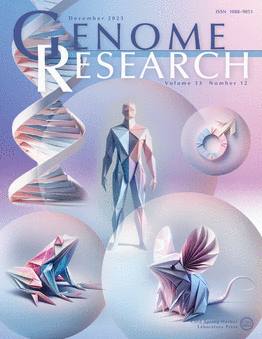Accurate detection of tandem repeats from error-prone sequences with EquiRep
IF 5.5
2区 生物学
Q1 BIOCHEMISTRY & MOLECULAR BIOLOGY
引用次数: 0
Abstract
A tandem repeat is a sequence of nucleotides that appear as multiple contiguous, near-identical copies arranged consecutively. Tandem repeats are widespread across natural genomes, play critical roles in genetic diversity, gene regulation, and are associated with various neurological and developmental disorders. They can also arise in sequencing reads generated by certain technologies, such as those used for sequencing circular molecules. A key challenge in analyzing tandem repeats is reconstructing the sequence of the underlying repeat unit. While several methods exist, they often exhibit low accuracy when the repeat unit length increases or the number of copies is low. Furthermore, methods capable of handling highly mutated sequences remain scarce, highlighting a significant opportunity for improvement. We introduce EquiRep, a tool for accurate detection of tandem repeats from erroneous sequences. EquiRep estimates the likelihood of positions originating from the same location in the unit through self-alignment, followed by a novel refinement approach. The resulting equivalence classes and consecutive position information are then used to build a weighted graph. A cycle in this graph with maximum bottleneck weight covering most nucleotide positions is identified to reconstruct the repeat unit. We test EquiRep on two applications, identifying repeat units from satellite DNAs and reconstructing circular RNAs from rolling-circular long-read sequencing data, using both simulated and raw sequencing datasets. Our results show that EquiRep consistently outperforms or matches state-of-the-art methods, demonstrating robustness to sequencing errors and superior performance on long repeat units and low-frequency repeats. These capabilities underscore EquiRep’s broad utility in tandem repeat analysis.用EquiRep准确检测易出错序列的串联重复序列
串联重复序列是核苷酸序列,表现为连续排列的多个连续的、几乎相同的拷贝。串联重复序列在天然基因组中广泛存在,在遗传多样性、基因调控中发挥关键作用,并与各种神经和发育障碍有关。它们也可能出现在由某些技术产生的测序读取中,例如用于测序环状分子的技术。分析串联重复序列的一个关键挑战是重建基础重复单元的序列。虽然存在几种方法,但当重复单位长度增加或拷贝数较低时,它们往往表现出较低的准确性。此外,能够处理高度突变序列的方法仍然很少,这突出了改进的重要机会。我们介绍EquiRep,一个工具,准确地检测串联重复序列的错误序列。EquiRep通过自对准来估计来自单元中同一位置的位置的可能性,然后采用一种新的改进方法。然后使用得到的等价类和连续位置信息来构建加权图。在这个图中,一个最大瓶颈权重覆盖大多数核苷酸位置的循环被确定来重建重复单元。我们在两个应用程序上测试EquiRep,使用模拟和原始测序数据集,从卫星dna中识别重复单元,并从滚动环状长读测序数据中重建环状rna。我们的研究结果表明,EquiRep始终优于或匹配最先进的方法,对测序错误表现出鲁棒性,在长重复单元和低频重复上表现优异。这些功能强调了EquiRep在串联重复分析中的广泛应用。
本文章由计算机程序翻译,如有差异,请以英文原文为准。
求助全文
约1分钟内获得全文
求助全文
来源期刊

Genome research
生物-生化与分子生物学
CiteScore
12.40
自引率
1.40%
发文量
140
审稿时长
6 months
期刊介绍:
Launched in 1995, Genome Research is an international, continuously published, peer-reviewed journal that focuses on research that provides novel insights into the genome biology of all organisms, including advances in genomic medicine.
Among the topics considered by the journal are genome structure and function, comparative genomics, molecular evolution, genome-scale quantitative and population genetics, proteomics, epigenomics, and systems biology. The journal also features exciting gene discoveries and reports of cutting-edge computational biology and high-throughput methodologies.
New data in these areas are published as research papers, or methods and resource reports that provide novel information on technologies or tools that will be of interest to a broad readership. Complete data sets are presented electronically on the journal''s web site where appropriate. The journal also provides Reviews, Perspectives, and Insight/Outlook articles, which present commentary on the latest advances published both here and elsewhere, placing such progress in its broader biological context.
 求助内容:
求助内容: 应助结果提醒方式:
应助结果提醒方式:


